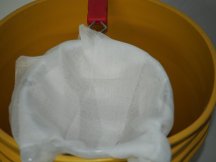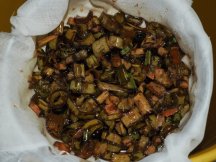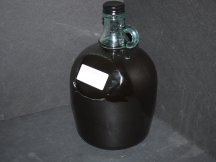J.James
Well-Known Member
Aloe FPJ (Fermented Plant Juice)
Step One
I use the Pups that the aloe throws out every year to make my aloe FPJ. You want to harvest your aloe in the morning before the sun hits the plant and at least 3 days since the last rain. Sunlight and rain both affect the microbial populations on the outside of the plant and we want them to be at peak populations to insure this fermentation happens fast and with the correct bacteria. Try to knock off as much dirt and debris as possible but DO NOT WASH IT. We don't want to do anything to disturb the surface microbes.

Step Two
We want to increase the service area so the microbes can do their thing. I remove the bottom roots and toss them into my worm bin or compost pile.

Then use a knife or scissors to cut the aloe into pieces or strips no larger than 1/2 inch. (Wear Gloves)

Step Three
You can use a glass container or a food-grade bucket for your fermentation process. When you have all your plant material cut and ready we will need to weigh it. You can do this before you start cutting if it is easier.

My bucket weighs 1.6 lbs giving me roughly 5.6 lbs of aloe

Step Four
Mix at a 1:1 ratio with sugar. I've seen people suggest Natural Brown Sugar & Brown Sugar. I use Turbinado Sugar or Raw Sugar and get good results. Stay away from processed white sugar and molasses.

I will use 4 1/2 lbs to mix with the aloe being sure to coat as much of the aloe as I can

Press the mix down to remove as much air as possible and then top the mix with 1 lb of sugar to make a cap so that I can not see any aloe sticking through the sugar. Use more sugar if needed to achieve this.

Step One
I use the Pups that the aloe throws out every year to make my aloe FPJ. You want to harvest your aloe in the morning before the sun hits the plant and at least 3 days since the last rain. Sunlight and rain both affect the microbial populations on the outside of the plant and we want them to be at peak populations to insure this fermentation happens fast and with the correct bacteria. Try to knock off as much dirt and debris as possible but DO NOT WASH IT. We don't want to do anything to disturb the surface microbes.
Step Two
We want to increase the service area so the microbes can do their thing. I remove the bottom roots and toss them into my worm bin or compost pile.
Then use a knife or scissors to cut the aloe into pieces or strips no larger than 1/2 inch. (Wear Gloves)
Step Three
You can use a glass container or a food-grade bucket for your fermentation process. When you have all your plant material cut and ready we will need to weigh it. You can do this before you start cutting if it is easier.
My bucket weighs 1.6 lbs giving me roughly 5.6 lbs of aloe
Step Four
Mix at a 1:1 ratio with sugar. I've seen people suggest Natural Brown Sugar & Brown Sugar. I use Turbinado Sugar or Raw Sugar and get good results. Stay away from processed white sugar and molasses.
I will use 4 1/2 lbs to mix with the aloe being sure to coat as much of the aloe as I can
Press the mix down to remove as much air as possible and then top the mix with 1 lb of sugar to make a cap so that I can not see any aloe sticking through the sugar. Use more sugar if needed to achieve this.









